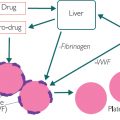Figure 13.1: Thyroid hormones
Hyperthyroidism
Hyperthyroidism is raised T4, leading to increased metabolic rate (often with a goitre), agitation and weight loss. Most cases are primary Grave’s autoimmune, although a rare secondary form caused by a tumour of the pituitary overproducing TSH also exists. It is often treated with anti-thyroid drugs (carbimazole), iodine and beta blockers. A primary condition is when the thyroid alone is affected. In a secondary condition, the pituitary is affected and over- or under-produces TSH, which in turn affects the thyroid.
Hypothyroidism
Hypothyroidism is low thyroid production, often with a reduced basal metabolic rate and weight gain. Most cases are primary Hashimoto’s autoimmune, which destroys the thyroid tissue. As discussed earlier, some other autoimmune conditions, such as pernicious anaemia, raise auto-antibodies against the thyroid. Physical and chemical damage from trauma and radiation, as well as inappropriate sex hormone signals (sometimes seen in endometriosis) can also reduce T4 production.
Table 13.1: Sample thyroid function test results

Thyroid treatments
T4 medication can take between four and six weeks to affect and stabilise TSH, and this would be the optimum time after which to repeat the TFT. If too much T4 is given, this will suppress the hypothalamus, and free T4 after six weeks will be very low. The usual range for T4 is 12.0–23.0pmol/L, and for TSH it is 0.4–5.0mU/L. Therefore a TSH of under 0.01mU/L usually indicates over-replacement; and 0.01–0.4 mU/L may mean some over-replacement, especially if free T4 is >30mU/L. A TSH of 0.4–5.0mU/L usually means that the T4 replacement is sufficient, whilst a TSH of >5.0mU/L indicates probable under-replacement or patient non-compliance. This is due to the pituitary still producing high amounts of TSH to encourage the thyroid to make T4 (which it won’t).
Since T4 can take up to six weeks to stabilise an adequate TSH response, patients newly commenced on thyroxine could have a repeat TFT around six to eight weeks post-intervention. Once the dose is stable, following a round of six-monthly TFT, you can then consider (if clinically appropriate) moving to an annual TFT.
Drugs such as carbimazole, normally prescribed to suppress T4 production, can be used to ‘block’ free T4, or they can be used as a therapy to ‘block’ before medicating with thyroxine to ‘replace’. As with T4 supplementation for hypo-conditions, TSH levels in patients with hyper-conditions may take up to 12 weeks to respond to carbimazole. In practice, you should consider carrying out a TFT every four to six weeks, then move to every three months once stable. For other treatments, such as radioiodine, consider an interval of four to eight weeks after dose, but take clinical advice in your own healthcare setting.
Stay updated, free articles. Join our Telegram channel

Full access? Get Clinical Tree




